Marjorie Fast and Peter Teichroeb Part 1: Marjorie's Story (1935)
Marjorie's Story
Copyright 2021 by Janice Teichroeb and Barry Teichroeb. All rights reserved.
This is the first in a series of four biographical accounts chronicling the experiences of Marjorie (Fast) Teichroeb and Peter Teichroeb growing up on the Prairies in the early to mid 1900’s. Interviews were conducted with Pete and Marj during the summer of 2021.
Marjorie Eileen Fast
Born 10 August 1935 - Rabbit Lake, Saskatchewan, Canada
Marjorie Eileen was born to parents Helena (Helen) Striemer and Albert Fast in the hospital at Rabbit Lake, Saskatchewan. Helen and Albert met in Laird one fall when Helen was working at a farm in Laird as a housekeeper and cook during threshing season. Albert grew up on a farm outside Laird where he worked on his father’s farm and found extra work as a farm hand, going from farm to farm during planting and threshing seasons. Helen was interested in Al but so was one of her friends. Helena ultimately won that contest. Al found work at a farm in Helen’s hometown of Rabbit Lake and moved to be closer to her. The couple subsequently married and lived in Rabbit Lake until after Marjorie was born.
While Marjorie was still a toddler, the family moved to a farm near Laird where Al worked as a farm hand. In the late 1930’s, Helen and Al purchased a parcel of land, about an acre in size, in the small town of Waldheim, located 15 km south of Laird. Marjorie and her family, including sister Helen and brothers Dale and Roger, lived in Waldheim until Marj finished high school. Marj’s sister Helen was born in 1939 in the hospital in Hepburn. Richard “Dale” was delivered by a nurse/midwife at the local medical clinic in Waldheim in 1943 and Roger was born at Saskatoon City Hospital in 1948.
Their home in Waldheim had a barn and chicken coop with enough property for the family to raise a pig and cow and to plant a large vegetable garden. The house was built from a pair of re-purposed granaries pulled together. The original granaries were of two-by-four construction with shiplap siding. To convert to a house, the interior walls were finished with lathe and mud plaster. Quarter inch by two-inch wooden lathe was nailed to the frame with quarter-inch gaps. Mud, clay based if they could find it, was applied to the walls, filling the gaps and creating a clean, smooth finish. The walls were whitewashed with a solution of powdered lime and water and the plank floors were painted.
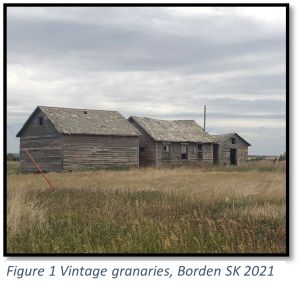
The house had two bedrooms, a kitchen and living room. Later the house was expanded with the addition of a summer kitchen moved from Grandma Fast’s home in Laird. It was moved to Waldheim and attached to the end of the house. Marj remembers that for a long time the end was open and covered only by a tarp, while preparations were made to assemble the new addition. Following construction of the addition, the walls were painted. It was very exciting.
This house never had plumbing and electrical service was only installed by about 1950. There was an outhouse in the yard and a well for drinking water. The well was also used for refrigeration. Since the temperature down in the well was very cold, butter and milk were lowered in a bucket and suspended just above the surface of the water. A wood fired, cast iron stove in the kitchen used for cooking and baking did double duty as a source of heat. A second coal burning heater was located in the living room. A glass window on the front let them keep an eye on the coal supply. Kerosene lamps were used for lighting the house.
The house had the usual furniture – a table and chairs in the kitchen and a couch in the living room. Much of the furniture was second hand or passed on to them by family or friends. There were two bedrooms, but as a young child Marj slept in the living room in a convertible bench on a straw filled mattress. By closing a lid, the bed converted to a bench for seating during the day. This was a rustic wooden box six feet long that opened to hold a straw mattress and when closed the lid was used as a seat. There was a back and arms on it so that when closed it was like a bench. Years later it was used outside for outdoor seating. When she was older, about seven years of age, Marj moved into one of the bedrooms, along with her sister Helen.
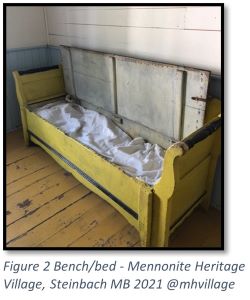
The house had a large walk-in pantry. Under the house was a root cellar, accessed through a trapdoor and stairs in the kitchen, for storing vegetables and other canned and preserved foods. For many years, the family would use rainwater that streamed off the roof through the eavestroughs and collected in a rain barrel for washing the laundry. In the winter they would collect snow and melt it on the stove. In later days an underground cistern was installed for storing rainwater that could be used year-round for the laundry.
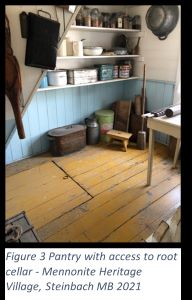
The town of Waldheim was very small at that time, the core being essentially a one block main street. Marj lived at the end of town, a few minutes’ walk from the main street. As a youngster of about 4 or 5, she could walk to town on her own. It was the custom in those days for people to purchase their supplies at the general store and charge the bills for later settlement. Adhering to this convention, Marj would walk to the store, purchase candy, and ask the shop keeper to charge it. It was a simple, convenient transaction and she was able to conduct business this way for quite a while before the shopkeeper quietly told her parents and the practice terminated.
The family was always well fed thanks to their ability to maintain a large vegetable garden and raise chickens, a cow, and a pig on their property. The cow and the chickens provided a continuous source of food staples in the form of eggs, milk, and butter. The pig, on the other hand, had a more tenuous life. A pig was purchased in spring, fattened through summer and autumn and slaughtered in November. This supplied ham, farmer sausage, liver sausage, pork roasts, lard and jreewe (cracklings).
Butchering was a major community event, with families, usually aunts and uncles, going from house to house during the butchering season. It was a day of hard work but also an opportunity to spend time with family and friends. Marj remembers the pig hanging in the yard, draining, before she left for school in the morning. After school she was put to work rendering the lard. Rendering entailed stirring over an open fire a cauldron containing all the trimmings from the pig that were not usable for main cuts of meat or sausage. In the rendering pot were ground up fatty cuts like bacon along with ribs. The rendering process deep fried the ribs and other meat and separated the lard. The lard was drained and strained and stored in clean pails to be used later for cooking and baking. The ribs (‘spareribs’) were set aside and eaten cold. The remaining settled meat, now fried and golden, called jreewe, was also stored in pails. The residual brown lard containing bits of fried meat, called jreewe schmault, was a favourite treat when spread on fresh bread.
Men and women performed different tasks on butchering day. Men killed and suspended the pig and then butchered it. They were responsible for the bulk of the heavy lifting. Pork roasts, pork shoulders and hams were cut.
Women were responsible for cleaning the intestines that were used as sausage casings, rendering the lard, and keeping everyone fed.
Two kinds of sausage were made. Farmer sausage, consisting of lean cuts of pork along with salt and pepper, was made using a machine that ground the meat and extruded it into the casings. Liver sausage was composed of one part ground liver and four parts ground lean meat, and it was packed into sealing jars.
At the end of the day, all helpers went home with spareribs, farmer sausage and liver sausage.
Farmer sausage and hams were smoked for three or four days in the yard. A temporary smokehouse was made for the purpose. It consisted of three wooden sides and one open side with a curtain. A fire was built from straw, primarily, and some wood, and the resulting coals were tended continuously until the smoking process was complete.
Hams were not baked as is the custom today. Rather, thick slices were cut and fried. These ham steaks were called schenkefleisch.
Al had severe health problems that led to twenty-two separate surgeries during his lifetime. Many were related to ulcers and other serious undiagnosed stomach ailments. His father and some brothers had many stomach problems as well. His father died of stomach cancer and several of Marj’s cousins were eventually diagnosed with celiac disease. Marj recalls a time when his stomach burst in the winter, and he had to be taken to Saskatoon on a closed Bombardier snowmobile. She remembers that from the alley off the main road leading to their house they could hear him moaning in pain. They had no telephone, but the town had a telephone office from which they could call to arrange for transportation to Saskatoon. Mother Helen would spend as much time at the hospital as she could but with a young family, she had to get home at night. Often, she was fearful that Al would not make it through the night. She would typically get a lift with local merchants heading to Saskatoon for supplies and leave the children alone for the day.
The family was quite poor, probably among the poorest in Waldheim but Marj never felt disadvantaged. The children always had lots of food and clean clothes. Marj even received an allowance. Initially she got a nickel but as she got older it was raised to a quarter. She had one set of school clothes that she wore every day. They were laundered on the weekend to be ready to go on Monday morning. She remembers one time, when Al was in the hospital for a particularly long time, that the town took up a collection for food and clothing for the family. It was actually kind of embarrassing to be at the receiving end of this charitable activity.
Usually Al milked the cow, but on the rare occasion when he or Helen were not around Marj’s sister Helen did it. She had a flair for it and, although younger than Marj, she was not afraid of the cow. Marj was. Marj collected eggs and fed the pig. The cow was an important source of income. Every other week the dairies in Saskatoon would pick up milk cans full of cream from local producers. The Fasts would collect excess cream in a gallon can and would sell about one per month to the dairy.
Mother Helen knit baby sweaters and sold them to earn cash income. Al worked at the local livery stable, caring for the horses, and transporting people to Laird in the winter with a cutter. When he was well, he also worked as a farm hand. When he was ill Helen received ‘mother’s allowance’, a monthly cheque for $25. In later years she worked as a cook at the Waldheim hospital. Much later when they had moved to Saskatoon Al worked as a boiler engineer at the General Motors warehouse.
During the summer after Marj completed grade 10, she went berry picking in British Columbia with her cousin Charlotte Fast. They picked strawberries for her Uncle Armin and Aunt Tina Fast in Abbotsford. Later in the summer Marj and Charlotte went to Matsqui to pick raspberries.
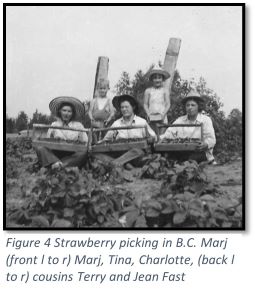
Visiting with grandparents was always a big event. Marj can still remember the smell of her Grandma Fast’s pantry; it always had the aroma of fresh cookies. Her grandmother was always very nice to the grandchildren. Memorable foods like fried potatoes and hamburgers, that looked more like meatballs, created lasting impressions.
Marj remembers her Fast grandparents coming to Waldheim to visit in a buggy drawn by a horse, and pulling up to the house she lived in. The buggy had a roof. Her grandfather, Jacob, always spoke Low German, never English, although he could understand spoken English. Her grandmother, Helena, was also more comfortable speaking Low German and so even after Jacob died the Fast brothers always spoke Low German around her and among themselves, even though they were brought up speaking fluent English.
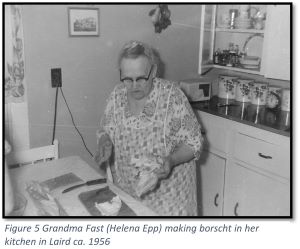
In total there were 52 grandchildren on the Fast side. The family got together frequently. Marj remembers visiting her grandmother one day and her grandmother telling her she was clearly pregnant, long before anything had been announced.
Marj did not see the Striemer family very often because they lived a long distance away from Waldheim. They would visit Waldheim a couple of times a year. There were no phones in those days and so the grandparents would just show up at the house unannounced. They were nice people although Grandma Striemer was quiet and insecure and would say strange things at times.
Marj recalls going out to visit the Striemer grandparents at their farm one time. It was fun because they had many animals. To a young child it seemed like a very long journey. Her grandmother Striemer was a very good cook.
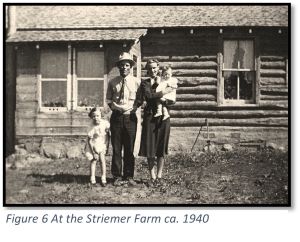
Christmas was always exciting. On Christmas Eve the children put out a bowl and, in the morning, it was filled with treats. They did not use stockings. They received one gift on Christmas morning. Marj recalls a doll she got one year, and when she was older, a white bible that she had requested. The main meal was a roast chicken. There was homemade candy such as peanut brittle and marshmallows. They did not have a Christmas tree until she was twelve years of age. She can remember picking decorations out of the Sears catalog that year. Christmas morning was always spent at home with the family. Later Al and Helen went to Laird to see grandma Fast and the children spent the day with Marj’s cousin Ruth and her siblings. Grandma Fast always sent home bags of treats for the children.
In the days preceding Christmas there was preparation for the annual Christmas concert. The school practiced for a couple of months and then the whole town attended the performance. Children received gifts from the teachers and gift bags from the school and the church.
In 1953 the property in Waldheim was sold and the family moved to Saskatoon. Marj had just graduated from high school. They purchased a small house at 1831 Saskatchewan Avenue North. It had no electricity, but she remembers when electricity was installed. They later purchased another small house on Avenue A, now Idylwyld Drive.
When Marj was growing up she had a lot of responsibilities. There were animals to look after, gardens, and without plumbing and electricity in small town Saskatchewan, every task took extra time and effort. By the time her youngest sibling, Roger, was born, times had changed a lot. He grew up in the city and everything was modern.
When the family first moved to the city Marj was not familiar with Saskatoon, and her father went with her to the employment office when she started hunting for a job. She found her first job in the city working as a salesperson at Kresge’s, one of the department store chains in Saskatoon at that time. She stayed there for a few months and hated the job. However, she soon found new employment at the University Hospital working for the Red Cross as a laboratory technician.
She enjoyed the work with the Red Cross. One of her main responsibilities was to wash and sterilize equipment used for blood drives, including operation of the autoclave equipment used for sterilizing the bottles that contained blood donations. Another was to prepare glucose and saline solutions used for storing blood. She remembers wearing a uniform with a beret.
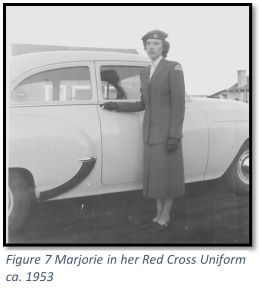
In Saskatoon she attended Mayfair Mennonite Church. There was a Young People’s group there, and this is where she first met Pete. He had a cousin who attended the church. As it happened this cousin was a friend of Marj’s, and they would walk to church together. Pete would routinely offer the cousin a ride home later, and Marj would go along. It took some time to figure out that the object of Pete’s attention was not the cousin.
In 1954, after Marj and Pete were married Pete lost his job at Saskatoon Motor Products after a failed attempt to have a union certified there. Marj quit her job at the Red Cross, and they moved to Rosthern where she worked at Friesen’s Department Store. It was a huge store and she worked there as a salesperson. This was a job she enjoyed. She had a colleague who was great to work with and they had a lot of fun. She started working there during the Christmas season and remembers receiving a large shipment of holly which was to be sold for 25 cents a sprig. The manager would have been surprised to learn that they sold whole bunches for that price!
In Rosthern they lived in a basement apartment that was very cold. When she complained to the landlord that they needed more heat the landlord suggested she put on more weight.
Pete got called back to work at Saskatoon Motor Products and they returned to Saskatoon. Marj was able to get another job at the University Hospital but found out she was pregnant and turned down the offer.
Post a comment